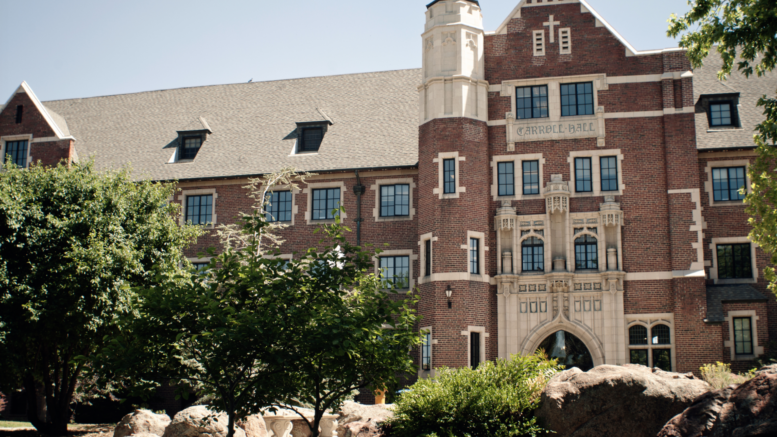
Aurora, Colorado-based Academy Roofing has been in business 41 years, tackling all types of residential and commercial roofing installation and service. The company’s recent re-roofing project at Carroll Hall, the administration building in the heart of the campus of Regis University, stands out for its many challenges — among them the sheer size and scope of the project, its tight schedule, and limited site access. “It might have been as tough a job as we’ve done since we’ve been open,” says Curt Boyd, president of Academy Roofing.
Originally built in the 1925 at the heart of the Jesuit university’s campus in Denver, the building has a 14/12 pitch roof that peaks more than seven stories in the air.
Academy Roofing installed 17,500 square feet of PABCO Premier Radiance Solar Reflective Shingles on the project. The shingles were specified because they matched other buildings on the campus and the solar reflectivity helped the university comply with the Denver Green Roofing Ordinance. Crews also installed copper window trim and applied a GACO silicone coating on some small low-slope sections. “We tore off the exiting roof, installed new decking, full ice and water shield, full old-school asphalt felt over it, and then we went with the PABCO Premier Radiance shingles,” Boyd says.
Challenging Logistics
Carroll Hall posed several logistical challenges. Academy Roofing called in a scaffolding company to build four stair towers to access the roof. Crews set up three areas for debris to minimize movement of material. A reach fork lift and a crane were used to remove trash during the tear-off.

During the tear-off, cranes and reach fork lifts were used to bring trash hoppers up to the work areas. Photos: Academy Roofing Inc.
“It’s an L-shaped building, so the inside portion offered less access and had a lot of landscaping and flagstone walkways that had to be protected,” Boyd notes. “There were trees that are taller than the eave line, and the eave line is 38 feet. There were certain areas we could not get right up against the building. For the tear off, we used trash hoppers and a reach fork lift to set the trash hoppers right below where the men were working. In areas where the trees posed a problem, we craned up and over to suspend the trash box.”
Work on the roof was divided into four sections. In each section, the crew began the tear off and re-sheeting process and installed the underlayment. As that work continued, two workers would fall back and begin installing the shingles. “They could install faster than the tear-off process, so as the tear-off was being completed on each section, the installation crews would just be catching up with them,” Boyd says. “We would wrap up one section and then move on to the next one.”
The detailed plan we executed to perfection. “It worked out well,” Boyd recalls. “We had 10 men on the job. Typically, on steep slope applications, we have three or four guys, so the logistics were more detailed. Where we could reach the eave line with no trees, we used a man lift to start the eave sections. We also used the man lift to do the coating and the copper trim around the windows.”
Crews coped with unusually hot summer weather, with temperatures averaging between 95 and 100 degrees. “There were five days over 100 degrees,” Boyd notes. “It’s summertime and we are used to dealing with the heat, but on the south-facing slope of a 14/12 roof, it felt like we were in an oven.”
The building was open and operational all summer, and the safety plan had to accommodate foot traffic for university employees, as well as participants in sports camps and other activities held on campus. Crews met daily to discuss the safety plan and the work scheduled for the day. A full-time supervisor of the site facilitated the crews and managed traffic, along with help from the university. “The plant personnel assisted us with access to our work, closing entrances and detouring people around our work zone and equipment,” Boyd notes. “The people that were in charge of the facilities were amazing. Anything that we needed, they were there to help us.”
The roof itself was also memorable. “What really stands out about this one is the height of the building and the slope of the roof,” Boyd recalls. “By the time the guys got to the top of the ridge line, they were seven stories off the ground. This building was intimidating.”

Four stair towers were erected to aid crews in accessing the roof.
The fall protection plan centered on personal fall arrest systems using attachment points at the peak of the roof.
The tight schedule was compressed even further by permitting delays, but Academy Roofing completed the job right on schedule. “We finished the building on the 17th of August, and they had registration on the 18th,” Boyd says. “We were able to make up some time because our men worked so well together and we had a good plan. I can’t say enough about our men and the effort they gave. It became their job. All of the guys had Regis University stickers on their hard hats. They did a great job.”
Teamwork was the key. “Our crew worked through all the challenges to succeed,” Boyd says. “We had constant communication with the facility people. Attention to the smallest details allowed us to complete the project with top-quality workmanship and minimal damage to the surrounding campus. After 41 years, it is still exciting for our people to take on a challenging project like this and succeed.”
TEAM
Roofing Contractor: Academy Roofing Inc., Aurora, Colorado, academyroofinginc.com
MATERIALS
Shingles: Premier Radiance Solar Reflective Shingles, PABCO, pabcoroofing.com
Roof Coating: GACO silicone coating, GACO, gaco.com

